Global Rf Over Fiber Market
市场规模(十亿美元)
CAGR :
% 
 2022
2029
2022
2029
| 2023 –2029 | |
|
|
|
|
>Global RF Over Fiber Market, By Modules (Transceivers, Optical Amplifiers, Antennas, Optical Switches, Optical Cables, and Others), Frequency Band (L Band, S Band, Ka Band, C Band, K Band, X Band, and Ku Band), Vertical (Civil and Military), Frequency Range (Less Than 30 GHz, 30 GHz to 40 GHz, 40 GHz to 50 GHz and More Than 50 GHz), Organization Size (Large Scale Organization, Medium Scale Organization and Small Scale Organization), Application (Telecommunications, Broadcast, Navigation, Radar and Broadband)- Industry Trends and Forecast to 2029.
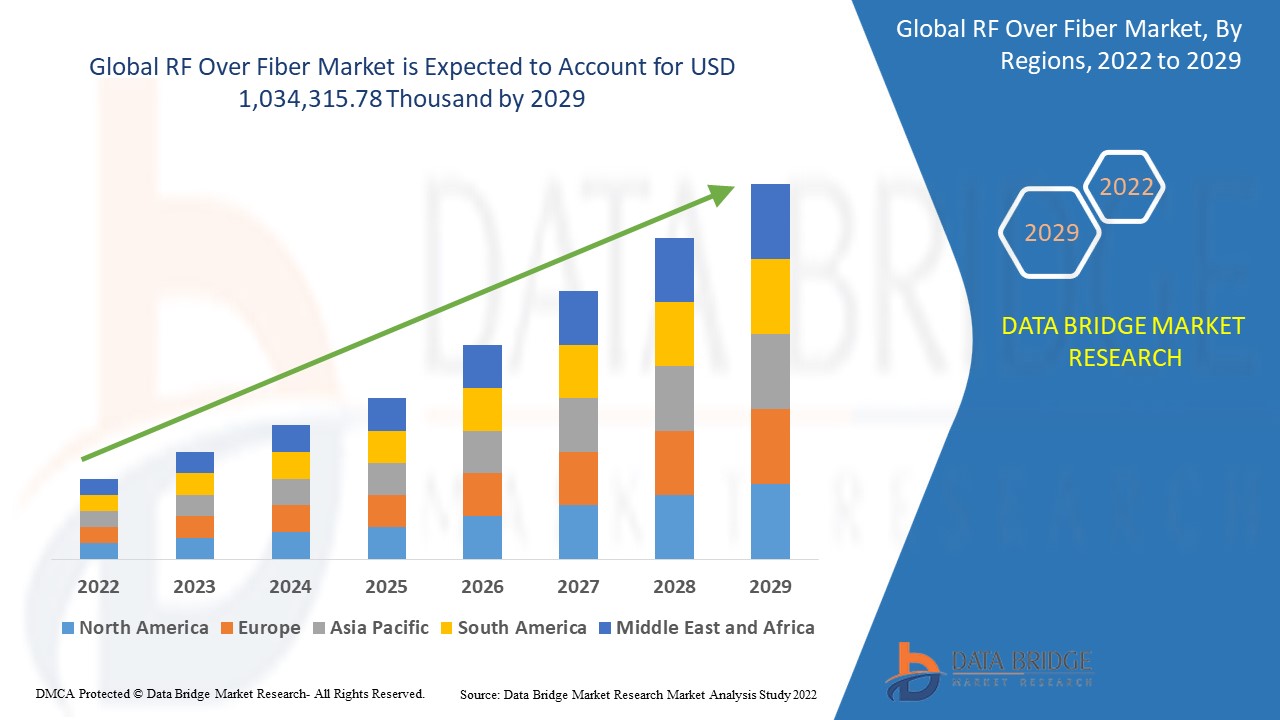
Market Analysis and Size
Technological development brought the enhanced internet service to support the consumer demand for faster internet connection, augmenting the increased count of fiber optic networks. This has been made possible as the population is getting more inclined towards digital platforms, internet services, and online services for their daily requirements. This increasing internet penetration is creating a huge demand for high bandwidth, high-speed internet services that are efficiently provided by the fiber-optic network. Thus, the increasing growth in fiber optic infrastructure increases the demand for RF over fiber.

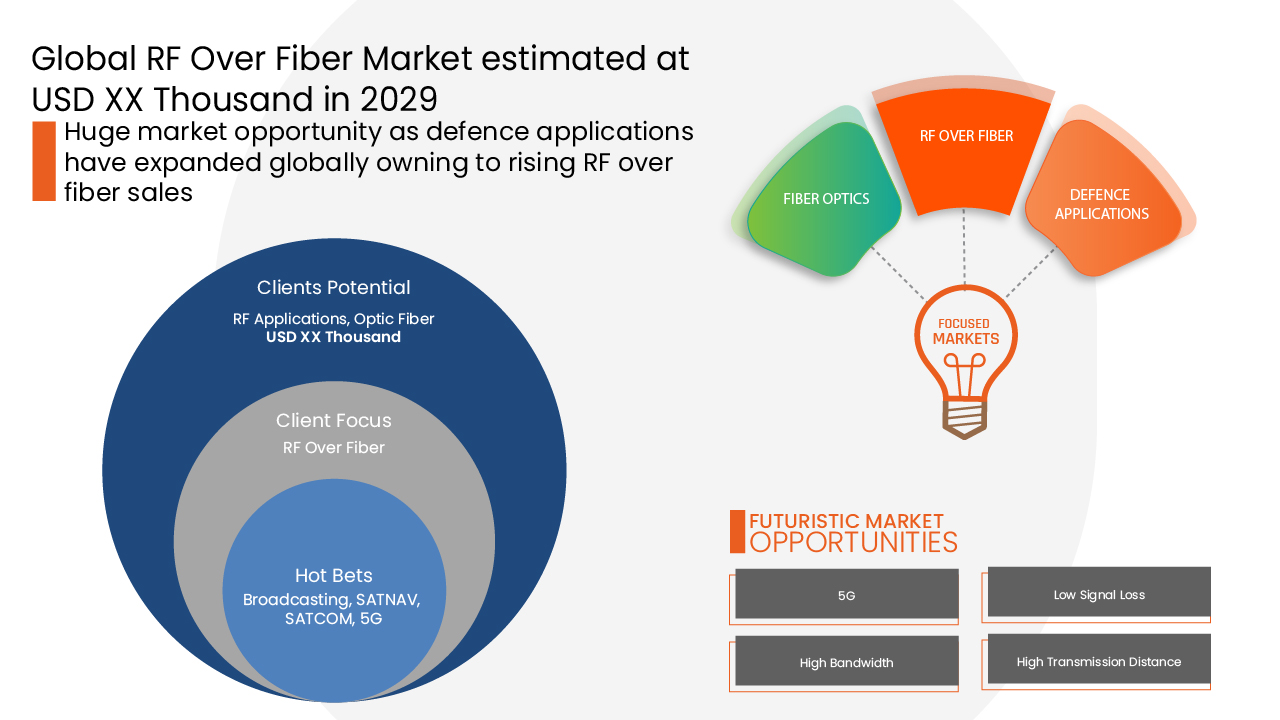
The major factor driving the market's growth is consumers' increasing demand for high-definition content. The high bandwidth offered by fiber-optic networks is a major factor in boosting the global RF over fiber market. However, the high initial cost required for building the infrastructure may restrain the market's growth.
Data Bridge Market Research analyses that the global RF over fiber market is expected to reach the value of USD 1,034,315.78 thousand by 2029, at a CAGR of 10.1% during the forecast period. "Transceivers" accounts for the largest modules segment in the global RF over fiber market. The global RF over fiber market report also covers pricing analysis, patent analysis and technological advancements in depth.
|
Report Metric |
Details |
|
Forecast Period |
2022 to 2029 |
|
Base Year |
2021 |
|
Historic Years |
2020 (Customizable to 2019-2014) |
|
Quantitative Units |
Revenue in USD Thousand, Pricing in USD |
|
Segments Covered |
Modules (Transceivers, Optical Amplifiers, Antennas, Optical Switches, Optical Cables, and Others), Frequency Band (L Band, S Band, Ka Band, C Band, K Band, X Band, and Ku Band), Vertical (Civil and Military), Frequency Range (Less Than 30 GHz, 30 GHz to 40 GHz, 40 GHz to 50 GHz and More Than 50 GHz), Organization Size (Large Scale Organization, Medium Scale Organization and Small Scale Organization), Application (Telecommunications, Broadcast, Navigation, Radar and Broadband) |
|
Countries Covered |
美国、加拿大和墨西哥、德国、法国、英国、荷兰、瑞士、比利时、俄罗斯、意大利、西班牙、土耳其、欧洲其他地区、中国、日本、印度、韩国、新加坡、马来西亚、澳大利亚、泰国、印度尼西亚、菲律宾、亚太其他地区、沙特阿拉伯、阿联酋、南非、埃及、以色列、中东和非洲其他地区 |
|
涵盖的市场参与者 |
Broadcom、EMCORE Corporation、APIC Corporation、Optical Zonu Corp、Gooch & Housego PLC、ViaLite、Global Invacom、HUBER+SUHNER、Glenair、SEIKOH GIKEN CO., LTD.、II-VI Incorporated、DEV Systemtechnik GmbH、Octane Wireless、Syntonics LLC、Intelibs, Inc.、ETL Systems Ltd、Narda-MITEQ、Olabs Technology Company Limited、RFOptic Ltd.、Elkay、MicroComp Nordic AB、Microwave Photonic Systems, Inc. 等 |
市场定义
光纤无线电 (RF over Fiber) 是一种光纤模拟传输技术,它使用无线电信号对光进行幅度调制并通过光纤链路传输以实现无线接入。虽然光纤无线电传输用于各种应用,包括有线电视 (CATV) 网络和卫星基站,但术语 RoF 最常与无线接入相关。在 RoF 系统中,无线信号以光学形式在中央站和一组基站之间传输,然后进行广播。每个基站都配置为与基站无线电范围内的至少一个用户的移动站进行通信。
全球射频光纤市场动态
本节旨在了解市场驱动因素、优势、机遇、限制和挑战。下面将详细讨论所有这些内容:
- 更高带宽对光纤电缆的需求不断增长
光纤带宽高,因为数据传输速度快,传输距离远,数据无衰减。光纤可以通过玻璃线等不同物体以光脉冲形式传输数据,使数据以光速传播。光通信有助于光束将信息从发射器传送到接收器。光频率通常接近红外线,约为一千 GHz。光纤为网络提供最高质量的数据和极小的信号干扰。
- 光纤电缆比铜缆更高效
铜缆带宽在速度和频率方面受到限制。光纤中传输数据的频率范围要宽得多。光纤可以在几分钟内从一个区域传输更多信息,而铜缆使用电信号传输数据的速度比通过光信号传输数据的光纤慢得多。
- 移动设备普及率提高
消费者可支配收入的增加和对先进电子产品的需求推动了消费电子市场的发展。消费者越来越精通技术,并在工作、日常生活、个人娱乐和其他方面采用新技术。智能设备由于控制、特性和其他功能的改进而占据了大部分市场份额。
- RFoF的低功耗优势
传输每比特数据所需的能量也可以决定系统的能源效率。功耗可以定义为每个用户的功耗与平均访问速率(瓦/Mbps)的关系,接入网络基础设施的功耗是使用网络分段创建的。制造商提供的有关各种典型硬件类型的设备能耗数据可用于计算系统各部分在一系列访问速率下的能耗。随着用户数量和每个用户的访问速率快速增长,这种视角为预测功耗上升提供了更好的平台。
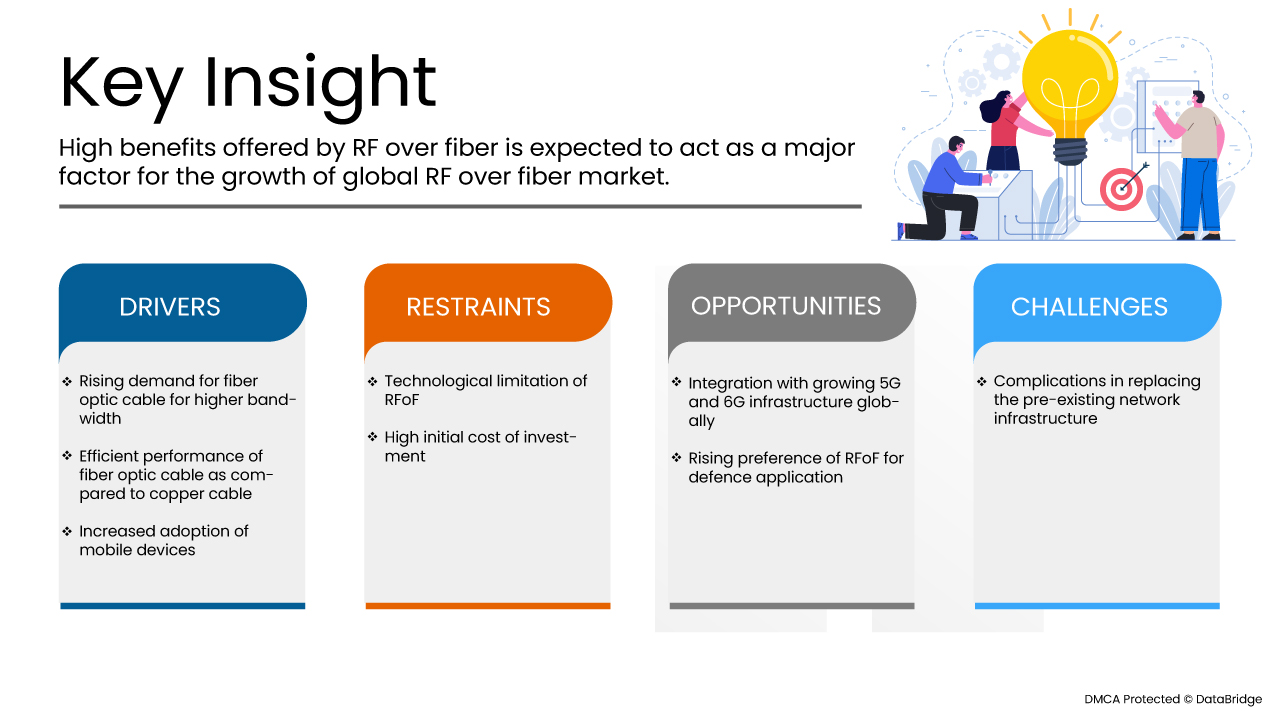
- RFoF 易于安装和维护
大多数 RoF 技术都不需要远程天线单元 (RAU) 中的本地振荡器和相关设备。复杂而昂贵的设备在 RoF 系统的头端维护,从而使 RAU 更加简单。由于高频电光调制器和电子设备成本高、功耗高,因此必须避免在 CS(中央站)中使用它们。此外,由于其生产和维护成本高,还应避免复杂的下行链路传输系统实施。头端装有调制和交换设备,由多个 RAU 共享。由于这种配置,RAU 更小更轻,从而降低了系统安装和维护成本。
- RFoF 的技术限制
单模光纤 RoF 系统中的色散会限制光纤连接长度并导致相位去相关,从而导致更高的射频载波相位噪声。模式色散严重限制了多模光纤 RoF 系统中可用的链路带宽和距离。尽管 RoF 传输方法是模拟的,但分布式无线电系统不必是模拟的(例如 WLAN 和 UMTS),并且可以使用广泛的多级信号调制格式,例如正交幅度调制 (QAM) 或正交频分复用 (OFDM)。
- 初期投资成本高
光纤射频网络具有高带宽、高速度和轻量等多种优势,但所有这些都伴随着高昂的投资成本。光纤网络组件非常昂贵。这就是为什么铜缆仍然受到青睐的原因,因为成本是选择网络类型的主要因素。这可能会抑制全球光纤射频市场的增长。加上收发器和所有其他组件的成本,总成本就会增加,导致公司投资成本高昂。电信行业更喜欢为最终用户使用铜缆基础设施,因为它的成本低。
COVID-19 对全球光纤射频市场的影响
COVID-19 对全球 RF 光纤市场产生了重大影响,因为几乎每个国家都选择关闭除生产必需品的工厂以外的所有生产设施。政府采取了严格的措施,例如停止非必需品的生产和销售、封锁国际贸易等,以防止 COVID-19 的传播。唯一应对这种流行病的企业是获准开放和运行流程的基本服务。
由于各国政府出台政策促进新冠疫情后的国际贸易,全球光纤射频市场正在增长。此外,光纤射频在优化成本和路线方面提供的优势也增加了市场对光纤射频的需求。然而,贸易路线拥堵和一些国家之间的贸易限制等因素正在抑制市场的增长。疫情期间生产设施的关闭对市场产生了重大影响。
制造商正在制定各种战略决策,以在新冠疫情后实现复苏。参与者正在进行多项研发活动,以改进光纤射频技术。借助此技术,这些公司将为市场带来先进而精准的解决方案。此外,政府促进国际贸易的举措也推动了市场的增长。
最新动态
- 2022 年 3 月,博通公司宣布展示其集成跨阻放大器 (TIA) 和高摆幅激光驱动器的 100G/通道光学 PAM-4 DSP PHY。它基于 112G PAM-4 DSP 平台构建,该平台提供最高级别的 CMOS 集成度和卓越的性能以及更低的功耗。因此,该公司将能够扩大其在市场上的产品组合
- 2021 年 11 月,HUBER+SUHNER 推出了可增强 4G 和 5G 连接的轨道天线。这款新型 SENCITY Rail MIMO+ 车顶天线采用先进的双极化天线技术,可增加整个列车的潜在 4G 和 5G 数据。借助此产品,该公司将能够扩大其在市场上的产品组合
全球射频光纤市场范围
全球 RF 光纤市场根据模块、频带、垂直、频率范围、组织规模和应用进行细分。这些细分市场之间的增长情况将帮助您分析行业中增长缓慢的细分市场,并为用户提供有价值的市场概览和市场洞察,帮助他们做出战略决策,确定核心市场应用。
按模块
- 收发器
- 光放大器
- 天线
- 光开关
- 光缆
- 其他的
根据模块,全球光纤射频市场分为收发器、光放大器、天线、光开关、光缆和其他。
按频带
- L 波段
- S 波段
- Ka波段
- C 波段
- K 波段
- X 波段
- Ku波段
根据频段,全球光纤射频市场细分为 L 波段、S 波段、Ka 波段、C 波段、K 波段、X 波段和 Ku 波段。
按垂直
- 民事
- 军队
在垂直基础上,全球光纤射频市场细分为民用和军用。
按频率范围
- 低于 30 GHz
- 30 GHz 至 40 GHz
- 40 GHz 至 50 GHz
- 超过 50 GHz
根据频率范围,全球光纤射频市场细分为低于 30 GHz、30 GHz 至 40 GHz、40 GHz 至 50 GHz 和高于 50 GHz。
按组织规模
- 大型组织
- 中型组织
- 小型组织
根据组织规模,全球光纤射频市场细分为大型组织、中型组织和小型组织。
按应用
- 电信
- 播送
- 导航
- 雷达
- 宽带
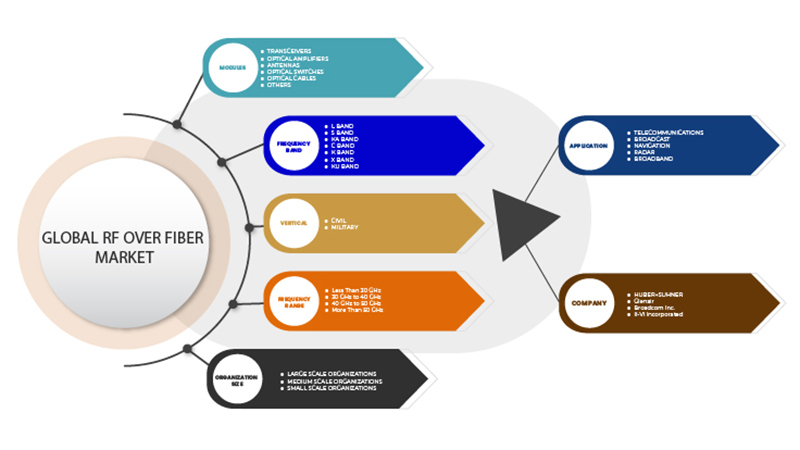
根据应用,全球光纤射频市场细分为电信、广播、导航、雷达和宽带。
全球射频光纤市场区域分析/见解
对全球光纤射频市场进行了分析,并按国家、模块、频段、垂直、频率范围和应用提供了市场规模洞察和趋势,如上所述。
全球射频光纤市场报告涉及的国家包括美国、加拿大和墨西哥、德国、法国、英国、荷兰、瑞士、比利时、俄罗斯、意大利、西班牙、土耳其、欧洲其他地区、中国、日本、印度、韩国、新加坡、马来西亚、澳大利亚、泰国、印度尼西亚、菲律宾、亚太其他地区、沙特阿拉伯、阿联酋、南非、埃及、以色列、中东其他地区和非洲。
北美地区的美国很可能是全球光纤射频市场增长最快的地区。北美处于技术发展的前沿,美国以 75.50% 的份额占据该地区的主导地位。北美是主要参与者和制造公司的中心,该地区需要光纤射频。
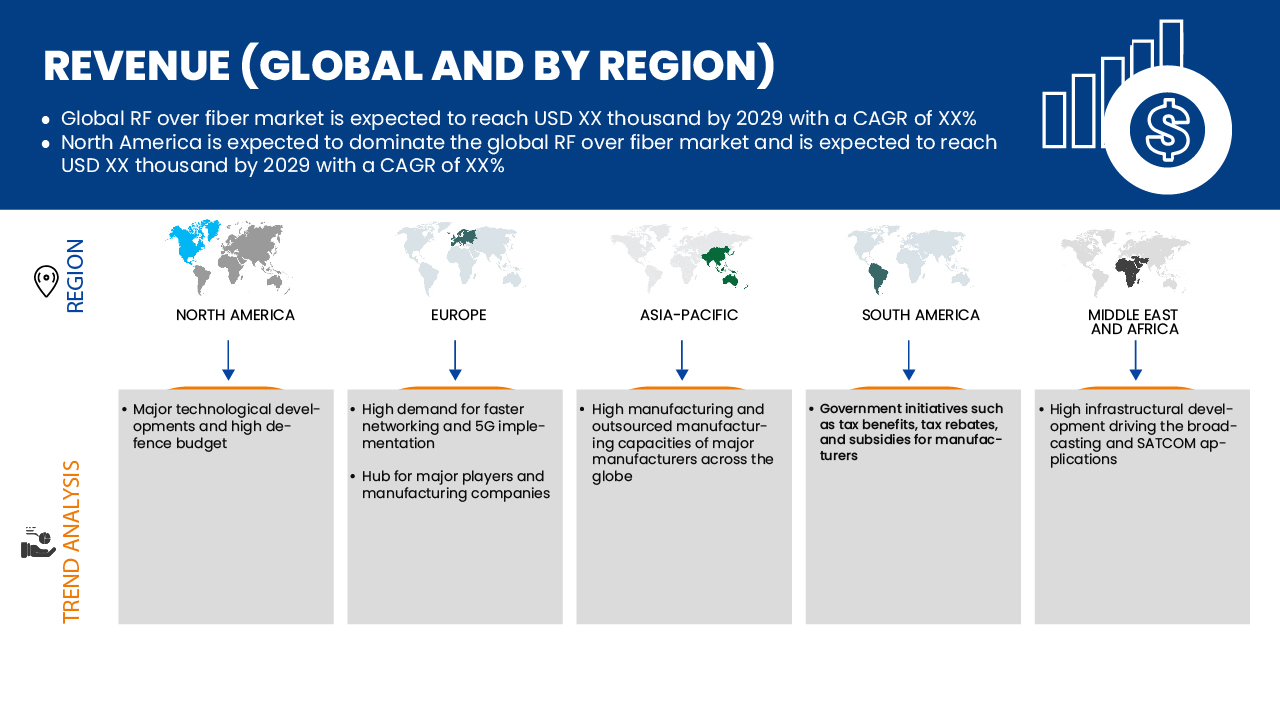
The country section of the report also provides individual market impacting factors and changes in market regulation that impact the current and future trends of the market. Data points like downstream and upstream value chain analysis, technical trends and porter's five forces analysis, and case studies are some of the pointers used to forecast the market scenario for individual countries. Also, the presence and availability of global brands and their challenges faced due to large or scarce competition from local and domestic brands, the impact of domestic tariffs, and trade routes are considered while providing forecast analysis of the country data.
Competitive Landscape and Global RF Over Fiber Market Share Analysis
The global RF over fiber market competitive landscape provides details by the competitor. Details included are company overview, company financials, revenue generated, market potential, investment in research and development, new market initiatives, global presence, production sites and facilities, production capacities, company strengths and weaknesses, product launch, product width and breadth, application dominance. The above data points provided are only related to the companies' focus related to the global RF over fiber market.
Some of the major players operating in the global RF over fiber market are Broadcom, EMCORE Corporation, APIC Corporation, Optical Zonu Corp, Gooch & Housego PLC, ViaLite, Global Invacom, HUBER+SUHNER, Glenair, SEIKOH GIKEN CO., LTD., II-VI Incorporated, DEV Systemtechnik GmbH, Octane Wireless, Syntonics LLC, Intelibs, Inc., ETL Systems Ltd, Narda-MITEQ, Olabs Technology Company Limited, RFOptic Ltd., Elkay, MicroComp Nordic AB, Microwave Photonic Systems, Inc., among others.
Research Methodology: Global RF Over Fiber Market
Data collection and base year analysis are done using data collection modules with large sample sizes. The stage includes the obtainment of market information or related data through various sources and strategies. It includes examining and planning all the data acquired from the past in advance. It likewise envelops the examination of information inconsistencies seen across different information sources. The market data is analysed and estimated using market statistical and coherent models. Also, market share analysis and key trend analysis are the major success factors in the market report. To know more, please request an analyst call or drop down your inquiry.
DBMR 研究团队使用的关键研究方法是数据三角测量,涉及数据挖掘、数据变量对市场影响的分析以及主要(行业专家)验证。除此之外,数据模型还包括供应商定位网格、市场时间线分析、市场概览和指南、公司定位网格、专利分析、定价分析、公司市场份额分析、测量标准、全球与区域和供应商份额分析。要了解有关研究方法的更多信息,请向我们的行业专家咨询。
SKU-
Get online access to the report on the World's First Market Intelligence Cloud
- Interactive Data Analysis Dashboard
- Company Analysis Dashboard for high growth potential opportunities
- Research Analyst Access for customization & queries
- Competitor Analysis with Interactive dashboard
- Latest News, Updates & Trend analysis
- Harness the Power of Benchmark Analysis for Comprehensive Competitor Tracking
研究方法
数据收集和基准年分析是使用具有大样本量的数据收集模块完成的。该阶段包括通过各种来源和策略获取市场信息或相关数据。它包括提前检查和规划从过去获得的所有数据。它同样包括检查不同信息源中出现的信息不一致。使用市场统计和连贯模型分析和估计市场数据。此外,市场份额分析和关键趋势分析是市场报告中的主要成功因素。要了解更多信息,请请求分析师致电或下拉您的询问。
DBMR 研究团队使用的关键研究方法是数据三角测量,其中包括数据挖掘、数据变量对市场影响的分析和主要(行业专家)验证。数据模型包括供应商定位网格、市场时间线分析、市场概览和指南、公司定位网格、专利分析、定价分析、公司市场份额分析、测量标准、全球与区域和供应商份额分析。要了解有关研究方法的更多信息,请向我们的行业专家咨询。
可定制
Data Bridge Market Research 是高级形成性研究领域的领导者。我们为向现有和新客户提供符合其目标的数据和分析而感到自豪。报告可定制,包括目标品牌的价格趋势分析、了解其他国家的市场(索取国家列表)、临床试验结果数据、文献综述、翻新市场和产品基础分析。目标竞争对手的市场分析可以从基于技术的分析到市场组合策略进行分析。我们可以按照您所需的格式和数据样式添加您需要的任意数量的竞争对手数据。我们的分析师团队还可以为您提供原始 Excel 文件数据透视表(事实手册)中的数据,或者可以帮助您根据报告中的数据集创建演示文稿。














